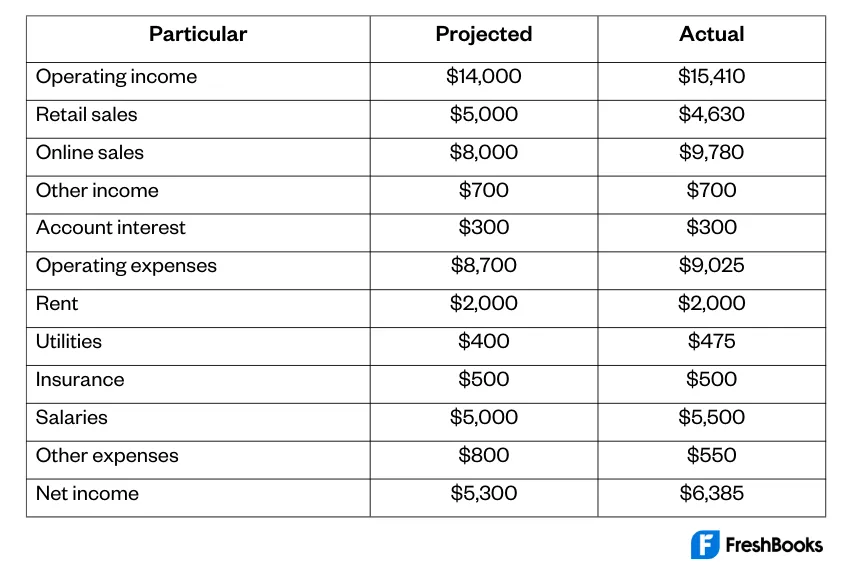Types of Budgets: 6 Common Budgeting Methods for Business

Have you ever tried to tackle a project, such as a home renovation, without creating a detailed budget first? If so, there’s a good chance you ran over budget and had to dip into savings to buy extra materials. Or maybe you finished the project with some money left over and realised you could have spent more on higher-quality products.
Either way, you would have learned an important lesson: Budgets are essential for the success of any project.
This lesson is particularly significant in business. Business plans may succeed or fail depending on the strength and preparation of one’s budget. And many small businesses don’t spend enough time creating formal budgets.
So, if you’re a business owner, now is the time to learn all about budgeting. Read on to learn more about the different types of budgeting methods.
Table of Contents
What Is the Budgeting Process?
What Is Budgeting?
Budgeting forms the foundation of a company’s financial plan. With budgets, an organisation can figure out how much money it needs to accomplish its goals. Each budget includes a breakdown of available capital, income, and expenses. This allows companies to calculate profitability and prioritise different business activities.
Without a budget, there’s no clear way to understand how well the business performs. So, all companies require budgets to quantify progress and success. This remains true for both one-person operations and multinational corporations.
A good budget allows an organisation to:
- Allocate resources effectively
- Set expectations across teams
- Measure financial success
- Predict potential revenue and profitability
- Stay aligned with business strategies
A budget should always include the following components:
- Revenue – This is the money the business brings in from sales. It includes all the money flowing into the business from various sources. It occupies the top spot on the budget.
- Fixed costs – These are recurring costs that don’t change according to your performance. For example, rent, utilities, insurance, accounting services, and salaries are all fixed costs.
- Variable costs – These are costs that may change based on business performance. For example, if your company sells shoes and one of them becomes a bestseller, your manufacturing costs will increase. Other variable costs include raw materials, logistics, commission, packaging, or production labour.
- One-off expenses- These are either start-up or individual costs that may arise unexpectedly. For example, moving expenses, office furniture, and software purchases are one-off expenses.
- Cash flow- This is the amount of money moving in and out of the business. You can calculate it by subtracting the money available at the start of a period from the money at the end. Positive cash flow is when more money comes into the business during a period than goes out. Understanding your cash flow helps you plan when to make certain purchases or investments.
- Profit – You calculate profit by deducting expenses from revenue. All businesses aim to increase profits over time, which is one of the key success metrics. Understanding profit is crucial for deciding where to direct funds for future business growth.

Types of Budget
Each type of budget has its advantages and disadvantages. Choose the one that best suits your industry and business objectives.
Master Budget
A master budget is a projection for the overall company. It offers a complete snapshot of how an organisation’s finances relate to each other by year or month.
For large-scale businesses, the master budget is a total of other budgets from several teams within the company. You use this to create a forecast for the entire year. For small businesses, a master budget is the main budget that covers all the different income and expense categories.
Operating Budget
An operating budget is a document that predicts how a business will make and spend money. It has similar features to a profit and loss report. It shows you the expected revenue and forecast expenses, such as fixed costs, capital costs, and variable costs.
Operating budgets are usually created at the start of the year. You use them to plan key business activities. The forecast often becomes less accurate the further out the prediction is. So, you’ll likely update the operating budget periodically.
Static Budget
You base a static budget on fixed expenses. These are all the costs not dependent on revenue. The budget won’t change—even if actual sales volumes differ from projected numbers.
Static budgets are helpful when a business has predictable revenue and expenses. For example, this method is often used by nonprofits that receive grants or donations. Since they can’t exceed this budget, they must plan their spending around a fixed budget.
Flexible Budget
Unlike a static budget, a flexible budget considers the actual revenue and expenses figures. For many businesses, sales volumes fluctuate throughout the year. This affects the money coming in as well as the money going out.
For example, if sales pick up more than expected during peak season, it will affect variable costs. In addition, inventory costs, supply chain logistics, and distribution costs may fluctuate. As a result, you can adjust the flexible budget to reflect the change in revenue and expenses.
Cash Budget
A cash flow budget is a good estimation of how much money will flow into and out of a business over a period of time. We may use this to see if the company has enough funds for regular operations. It may also provide insight into the best way to allocate funds.
You create cash flow budgets by looking at sales forecasts and production numbers. You also have to estimate sales volumes.
This type of budget can help you evaluate whether you have enough liquid cash to operate. It can also provide insight into whether your money is being used productively and if there’s an opportunity to make a profit.
Labour Budget
Labour budgets are explicitly for staffing purposes. They help companies understand the cost of labour according to the value of their output. When a company knows the actual cost of their labour, it allows them to allocate expenses more efficiently.
Budgeting Methods
There’s no single best way to approach a business budget. Different industries may follow their own best budgeting practices. And small businesses often combine different methods. Below are some of the most common budgeting methods.
Zero-Based Budgeting
Zero-based budgeting is for when companies want to constrain spending. It assumes that all departments start with zero budget, and each cost must be rebuilt from scratch. This means that managers must justify every expense, with the aim of cutting as many costs as possible.
Zero-based budgeting is time-consuming, as it requires an in-depth examination of departmental operations. However, it may be necessary for companies going through financial restructuring. It also may be necessary during market downturns.
Incremental Budgeting
This is one of the most common budgeting techniques. It takes the previous period’s actual numbers and adds or subtracts a percentage to generate the current budget. It’s a straightforward approach that you should use when your primary income sources and expenses are similar from year to year.
However, incremental budgeting is not the most accurate method. It may result in a slack or inefficient budget because individual costs are not re-evaluated.
Rolling Budgeting
Rolling budgets are continually updated by adding a new budget period when the most recent one has finished. They’re updated monthly, meaning the existing budget is always extended 1 year into the future.
This method is ideal for companies that operate in fast-moving or unpredictable industries. Rolling budgets allow for more flexibility and continuous alignment with current conditions. But they also require significant time and resources to manage since they’re updated frequently.
Activity-Based Budgeting
Activity-based budgets use a top-down approach to achieve company targets. For example, suppose a company sets a goal of $1 million in revenue. The company will first establish the activities needed to reach this target. Then it will determine the cost of these activities.
Value Proposition Budgeting
Value proposition budgeting aims to ensure that each budget item delivers value for the company. If a budget item does not create value for clients, staff, or stakeholders, you should reconsider it. Like the zero-based approach, this method allows you to review costs and cut unnecessary expenses.
Participative Budgeting
In participative budgeting, lower-level employees recommend targets to higher-level decision-makers. This method assumes that each department is best positioned to understand necessary expenses. Departments should also know where to relocate those funds.
What Is the Budgeting Process?
While there’s not a single correct way to approach budgeting, you should always do it early. This will ensure there is more time for planning activities around the budget.
Most companies start planning budgets 4 to 6 months before a new financial period starts. Then, after approval and implementation of the budget, you should install monthly reviews to keep things on track.
Below is an overview of some of the main steps in the budgeting process.
1. Review Previous Periods
This only applies if your budget is already implemented. If it is, consider its effectiveness.
For instance, are you going over or under the projected budget? Was anything left out that you should include in the future? Were your projections off-base or on-point? Use these insights to create your new budget.
2. Figure Out Your Income Sources
Calculate all of your existing revenue sources. How much money are you currently making? What are the projected sales volumes for the rest of the period? This may be coming from a single source or from several.
3. Input Fixed Costs
Tally up all the costs that stay the same from month to month. These are things like rent, certain utilities, and sometimes payroll. Review any existing expense reports to find fixed costs that you may have overlooked.
4. Include Variable Costs
Calculate the various costs that change each month. For example, sales commissions, travel, logistics, and production costs may vary from period to period.
5. Predict One-Off Costs
Some costs are only incurred infrequently, such as equipment upgrades. Try to predict as many of these costs as possible when creating your budget.
6. Bring It All Together
Add up all your expenses and compare them to your incoming cash flow. This will help you estimate your overall profitability.
Example of Budgeting
Here’s an example of a basic business budget. Add as many detailed income or expense sources as possible to create a more realistic picture of your business finances.

Key Takeaways
When running a business, it’s essential to understand the difference between budget types. And you must know how to plan them effectively. Without enough preparation, it’s easy to miss the mark when it comes to your budgeting goals. Budgeting is crucial to operating a profitable business.
Whatever budget you want to create, it’s important to choose the right accounting software. While you can always manually input figures on a spreadsheet, accounting software automates a lot of the busy work. It may also include other features like analytics, expense tracking, collaboration tools, and more.
FAQs on Types of Budgets
What Type of Budget Do Most Companies Use?
Incremental budgets are very popular. It takes the previous period’s budget and adds or subtracts a percentage to determine the new budget. Plus it’s quite easy to understand at a glance.
What Is the Importance of Budgeting?
Budgeting is important because it provides a financial picture of a company’s performance. It describes all the money a business spends and all the money it makes.
Without a budget, it would be hard to know where to allocate financial resources for business profitability. Budgets also keep everyone involved and on the same page, which stimulates further growth.
What Are Budgeting Tools?
Budgeting tools are online software that help you with financial planning. They are helpful for managing a business. Some budgeting tools allow you to create a budget in a spreadsheet, while others allow you to input your financial data. There is also software with analytical reports, profitability forecasts, and collaboration features.
What Are the 4 Stages of the Budget Process?
There are 4 key stages in the budget process. The first stage is preparation, when you create the budget. Next, the budget needs to get approved. Third, you must install the budget in business operations. Finally, evaluate and revise the budget according to its effectiveness.
Is a Budget a Plan?
A budget is a vital component of a plan, but they are not the same. A plan describes the activities a business must carry out to reach objectives. In contrast, a budget describes the financial factors that influence these activities.
RELATED ARTICLES


 Retained Earnings: Definition, Formula & Example
Retained Earnings: Definition, Formula & Example Feasibility Study: Meaning, Types & Process
Feasibility Study: Meaning, Types & Process What Is Direct Debit Guarantee & Direct Debit Rules?
What Is Direct Debit Guarantee & Direct Debit Rules? What Is a Risk-Free Rate of Return? Definition & Example
What Is a Risk-Free Rate of Return? Definition & Example What Is a Control Account?
What Is a Control Account? What Is a Purchase Requisition Form? A Guide
What Is a Purchase Requisition Form? A Guide